The Featured Creatures collection provides in-depth profiles of insects, nematodes, arachnids and other organisms relevant to Florida. These profiles are intended for the use of interested laypersons with some knowledge of biology as well as academic audiences.
Introduction
The Australian cockroach is one of several species of peridomestic cockroaches (cockroaches that live mostly outdoors, but occasionally may be found indoors) and the most common cockroach species found outdoors in southern Florida. This species resembles the American cockroach but can be distinguished by the presence of light yellow bands on upper margins of the forewings (Figure 1).
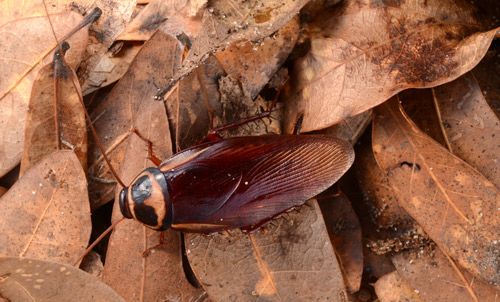
Credit: Lyle J. Buss, UF/IFAS
Synonymy
Periplaneta australasiae Fabricius (1775)
Blatta australasiae Fabricius (1775)
Blatta domingensis Palisot de Beauvoistwo (1805)
Blatta aurantiaca Stoll (1813)
Periplaneta zonata Haan (1842)
Periplaneta repanda Walker, F. (1868)
Periplaneta subcincta Walker, F. (1868)
Periplaneta inclusa Walker, F. (1868)
Periplaneta emittens Walker, F. (1871)
Polyzosteria subornata Walker, F. (1871)
Obtained from https://eol.org/pages/1076924/names/
Distribution and Habitat
In the US, the Australian cockroach is most prevalent in Florida and the coastal southeastern states (Barcay 1990). According to Rehn (1945), this species may have originated in Africa and arrived in America by the slave ship route centuries ago.
According to Kramer et al. (2009), the Australian cockroach is typically found outdoors, establishing stable colonies and occupying similar habits with the smoky brown cockroach, Periplaneta fuliginosa Serville. The Australian cockroach can be found under the bark of trees, in firewood piles, and in locations with moisture. This species can survive indoors in subtropical areas when colder temperatures are present. In these situations, the cockroach may inhabit greenhouses, causing damage to plants (especially seedlings). Other indoor habitats where the Australian cockroach can be found include water pipes, sinks, toilets, cupboards, and other environments with dark and warm conditions (Figure 2).

Credit: Lyle J. Buss, UF/IFAS
Description
Eggs
The eggs are deposited into an ootheca (a structure where eggs are held together) with a length of up to 11 mm (⁷⁄₁₆ in) (Kramer et al. 2009). The ootheca is attached to and carried by the adult female on the tip of her abdomen and deposited long before the eggs hatch (Cornwell 1968) (Figure 3).
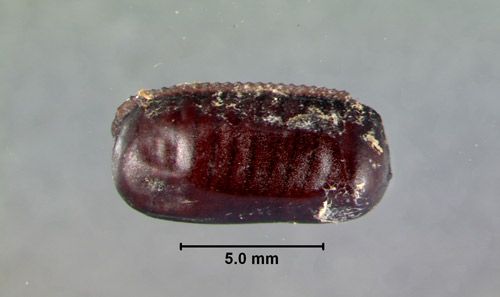
Credit: Lyle J. Buss, UF/IFAS
Nymphs
Nymphs are wingless, although wing bud structures may be present in later stages. Light-yellow spots on top of the abdomen can be found on the nymphs of the Australian cockroach (Kramer et al. 2009). This is a characteristic that can distinguish this species from other species of the genus Periplaneta. The nymphs become mottled (spotted or blotchy) gradually as they molt through the five nymphal instars, as shown in Figure 4.
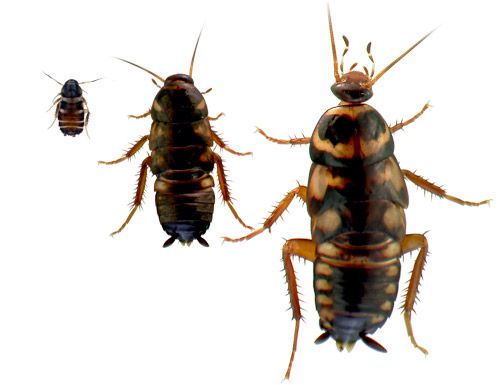
Credit: Urban Entomology Laboratory, University of Florida
Adults
The adults are about 32–35 mm (1¼–1 1/3 in) long and range in color from reddish-brown to dark-brown and have completely developed and functional wings, capable of gliding flight. As shown in Figure 1, a light-yellow band can be found on the outer edge of both wings near their attachment site (Kramer et al. 2009).
It is difficult to distinguish adult male and female Australian cockroaches from the dorsal (top) side. However, characteristics at the tip of the abdomen can be used for discrimination. The adult male cockroach has two pairs of appendages at the tip of the abdomen (a pair of styli and a pair of cerci) (Figure 5). However, the adult female has only one pair of appendages in that area (a pair of cerci). Additionally, an abdominal plate (flat structure) projects beyond last true segment of the female (Figure 6).
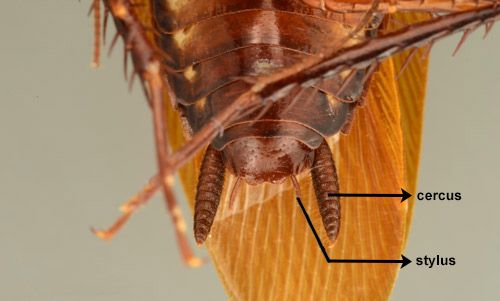
Credit: Lyle J. Buss, UF/IFAS
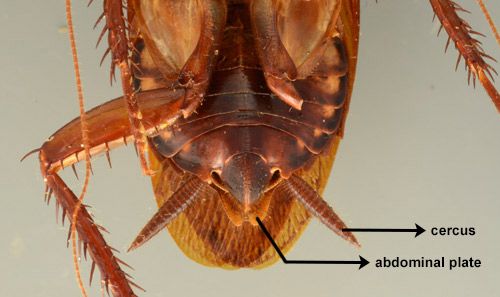
Credit: Lyle J. Buss, UF/IFAS
Life Cycle
A complete life cycle of the Australian cockroach includes the eggs, five nymphal instars, and the adult. An ootheca may contain 24 embryos, which require about 40 days to complete embryonic development (Kramer and Brenner 2009). The nymphal stage takes 6–12 months. Nymphs mature slower when reared alone than when reared collectively (Willis 1958). It takes about 24 days for a newly molted female to produce the first ootheca (Cornwell 1968). The ootheca is often dropped or glued in hidden cracks and crevices. An adult female can lay about 20–30 oothecae in her lifetime. Development to the adult stage requires about one year, with adult females surviving for an additional four to six months (Kramer and Brenner 2009).
Medical Importance
Cockroaches are closely associated with humans and commonly dwell in places of poor sanitation. These pests may affect human health in several ways, such as food contamination by their excrement, mechanical dissemination of pathogens, and induced allergies. The potential for cockroaches to mechanically transmit pathogens has been proposed due to the recovery of at least 32 species of bacteria in 16 genera, 17 fungal species, and three protozoan species from cockroaches recovered from both indoor and outdoor environments (Kramer et al. 2009). Additionally, it was reported from laboratory experimentation that the Australian cockroach can vector Salmonella (a causative agent of food poisoning) serotype Kottbus (Mackerras et al. 1948). However, incrimination of the Australian cockroach in a food contamination outbreak has not been demonstrated. It is important to recognize that although many pathogens have been isolated from cockroaches, it has not been proven that cockroaches serve as competent vectors of these pathogenic organisms.
Another human risk attributed to cockroaches includes induced allergies caused by inhalation, ingestion, dermal abrasion or injection of cockroach-produced allergens. It has been documented that about one-half of asthmatic patients are allergic to cockroaches. Symptoms of allergies caused by cockroaches can be sneezing, skin reactions, and eye irritation (Wirtz 1980). More severe allergic reactions can present as breathing difficulty or anaphylactic shock (symptoms including an itchy rash, throat swelling, and low blood pressure), which is life-threatening (Brenner et al. 1991).
Management
Because the Australian cockroach primarily lives outdoors, an IPM approach that includes preventing entry into structures is recommended. For example, door thresholds should be installed tightly; a space the width of a quarter is enough to allow entry. A simple way to look for cracks is by standing inside a structure and checking whether light comes through cracks around doors or windows. Additionally, habitat removal, such as removing woodpiles near the house, would be an effective way to control Australian cockroaches. If there is an infestation (not just an introduction), sticky card monitors could be used to determine entry points. Application of pesticides, if needed, should strictly follow the pesticide label.
Detailed information about effective control of cockroaches can be found at Insect Management Guide for Cockroaches.
Selected References
Barcay SJ. 1990. Cockroaches. In Mallis A (Editor), Handbook for Pest Control, 7th edition. Cleveland, OH: Franzak & Foster Co. 1152 pp.
Brenner RJ, Barnes KC, Helm RM, Williams LW. 1991. "Modernized society and allergies to arthropods: Risks and challenges to entomologists." American Entomologist 37: 143–155.
Cornwell PB. 1968. The cockroach. Vol. I: A Laboratory Insect and an Industrial Pest. London: Hutchinson & Co. Ltd. 391 pp.
Kramer RD, Brenner RJ. 2009. Cockroaches (Blattaria). In Mullen GR, Durden LA (Editors), Medical and Veterinary Entomology, 2nd edition. Burlington, MA: Elsevier 637 pp.
Mackerras IM, Pope P. 1948. "Experimental Salmonella infections in Australian cockroaches." Australian Journal of Experimental Biology and Medical Science 26: 465–470.
Rehn JAG. 1945. "Man's uninvited fellow traveller—the cockroach." Science Monthly 61: 265–270.
Willis ER, Riser GR, Roth LM. 1958. "Observations on reproduction and development in cockroaches." Annals of the Entomological Society of America 51: 53–69.
Wirtz RA. 1980. "Occupational allergies to arthropods—documentation and prevention." Bulletin of the Entomological Society of America 26: 356–360.